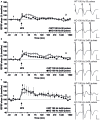Afferent Input Selects NMDA Receptor Subtype to Determine the Persistency of Hippocampal LTP in Freely Behaving Mice
- PMID: 27818632
- PMCID: PMC5073893
- DOI: 10.3389/fnsyn.2016.00033
Afferent Input Selects NMDA Receptor Subtype to Determine the Persistency of Hippocampal LTP in Freely Behaving Mice
Abstract
The glutamatergic N-methyl-D-aspartate receptor (NMDAR) is critically involved in many forms of hippocampus-dependent memory that may be enabled by synaptic plasticity. Behavioral studies with NMDAR antagonists and NMDAR subunit (GluN2) mutants revealed distinct contributions from GluN2A- and GluN2B-containing NMDARs to rapidly and slowly acquired memory performance. Furthermore, studies of synaptic plasticity, in genetically modified mice in vitro, suggest that GluN2A and GluN2B may contribute in different ways to the induction and longevity of synaptic plasticity. In contrast to the hippocampal slice preparation, in behaving mice, the afferent frequencies that induce synaptic plasticity are very restricted and specific. In fact, it is the stimulus pattern and not variations in afferent frequency that determine the longevity of long-term potentiation (LTP) in vivo. Here, we explored the contribution of GluN2A and GluN2B to LTP of differing magnitudes and persistence in freely behaving mice. We applied differing high-frequency stimulation (HFS) patterns at 100 Hz to the hippocampal CA1 region, to induce NMDAR-dependent LTP in wild-type (WT) mice, that endured for <1 h (early (E)-LTP), (LTP, 2-4 h) or >24 h (late (L)-LTP). In GluN2A-knockout (KO) mice, E-LTP (HFS, 50 pulses) was significantly reduced in magnitude and duration, whereas LTP (HFS, 2 × 50 pulses) and L-LTP (HFS, 4 × 50 pulses) were unaffected compared to responses in WT animals. By contrast, pharmacological antagonism of GluN2B in WT had no effect on E-LTP but significantly prevented LTP. E-LTP and LTP were significantly impaired by GluN2B antagonism in GluN2A-KO mice. These data indicate that the pattern of afferent stimulation is decisive for the recruitment of distinct GluN2A and GluN2B signaling pathways that in turn determine the persistency of hippocampal LTP. Whereas brief bursts of patterned stimulation preferentially recruit GluN2A and lead to weak and short-lived forms of LTP, prolonged, more intense, afferent activation recruits GluN2B and leads to robust and persistent LTP. These unique signal-response properties of GluN2A and GluN2B enable qualitative differentiation of information encoding in hippocampal synapses.
Keywords: GluN2A; GluN2B; LTP; NMDA; hippocampus; in vivo; mouse; synaptic plasticity.
Figures



References
-
- Bannerman D. M., Niewoehner B., Lyon L., Romberg C., Schmitt W. B., Taylor A., et al. . (2008). NMDA receptor subunit NR2A is required for rapidly acquired spatial working memory but not incremental spatial reference memory. J. Neurosci. 28, 3623–3630. 10.1523/JNEUROSCI.3639-07.2008 - DOI - PMC - PubMed
-
- Bartlett T. E., Bannister N. J., Collett V. J., Dargan S. L., Massey P. V., Bortolotto Z. A., et al. . (2007). Differential roles of NR2A and NR2B-containing NMDA receptors in LTP and LTD in the CA1 region of two-week old rat hippocampus. Neuropharmacology 52, 60–70. 10.1016/j.neuropharm.2006.07.013 - DOI - PubMed
LinkOut - more resources
Full Text Sources
Other Literature Sources
Research Materials
Miscellaneous

